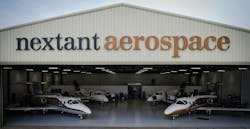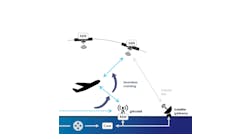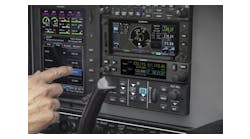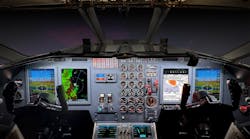At the Richard D. Shea/Cuyahoga County Airport in East Cleveland, there is a quiet airplane manufacturer hard at work. The Nextant 400 XTi is the result of a revolution in thinking, on the part of both the company and the FAA. One of only two such businesses in the country (the other is the IKHANA factory in California, where Twin Otters are “re-lifed”), the Nextant jets are, like TV documentaries, “based on” existing design; but the end result is so different, that the resulting airplanes are new. Don’t ask me; ask the FAA. As these planes go out the door, they wear a new data plate with a new date of manufacture and production number.
Starting with the Hawker 400A/XP (which itself derives from the Beechjet 400, which came from the Mitsubishi MU-300 Diamond) new acoustic insulation from N2 Aero [www.n2aero.com] allow a new composite inner shell, which runs the full length of the pressurized area, from Jeff Bonner Research & Development of San Antonio, TX [www.JBRND.com] to actually add space inside – an increase of 3 inches in shoulder width and 2 ½ inches in height. The insulation isn’t just smaller; it’s a lot quieter. Nextant says that the donor Hawker 400XP cabin has an ambient noise level of about 81 db at FL410. That’s not bad, and it’s typical of light jets of that era. The Nextant XTi interior registers 72-73 db. Considering that a 3 db drop is perceived as about half the noise, the new interior is only about one-eighth as loud as the original.
Several Hawker owners, inspecting the Nextant, have asked where the fuselage “plug” was added. In addition to the actual increase in interior volume, the perception of added space is enhanced by a re-thinking of seating arrangements. Most light jets have a “club-forward” seating arrangement; the Nextant interior has the club seating at the rear. This, coupled with the three-seat divan that allows a 6-foot 5-inch long reclining rest area, optimizes the arrangement for the most-used PAX configuration. (Nextant’s research shows that most trips have no more than three to four passengers, though the interior typically seats seven – plus the lav.) President Sean McGeough explains, "The company was created to meet specific market demands in today’s light jet sales market."
Unlike a mod shop or completion center, Nextant is set up like an OEM, but with added customization options. All the mounting points for all the options are included in all the airframes. Standardized options will all fit, without custom work. This allows the most-popular floorplans to all be accommodated without additional airframe modification. McGeough is proud that the “cookie cutter” approach can yield a truly custom look and feel. “Unlike other light jet manufacturers that offer limited interior selections, we have the highest standards and materials for our customers to choose from,” which, he says, “is particularly important in the international market."
Specifics help illustrate the depth of the operation
The weak points and the “corrosion farms” of the airframe are well-known. Nextant not only disassembles much of the original aircraft; it manufactures new and improved parts. In the horizontal tail, for example, you will find new, stronger ribs. These more-rigid components do a better job of supporting the skin, and thus reduce fretting and loosening of rivets, introduction of water, and so on.
Performance (both power and economy) is addressed in the addition of all-new Williams FJ-44-3AP, which, in addition to a longer (5,000 hour) TBO, faster climb to altitude, and shorter takeoff, also burn up to 25 percent less fuel. Just “bolting these on” was not the case. Entirely new pylons and attachments, changes in fuel delivery, and new nacelles were part of the deal.
“The new Williams Engine installation provides for a weight savings of approximately 120 pounds per side - this actually favors the CG profile for the aircraft and it is nearly impossible to load the plane outside of that envelope,” says Jay Heublein, Nextant Aerospace executive vice president, Global Sales and Marketing, “and the redesign of the nacelle structure creates a significant lifting surface not found in the predecessor aircraft; this provides for improved slow speed handling characteristics.”
The new nacelles allow better inspection and quicker access. While the original nacelles were positioned in the classic way, the new nacelles are held in place with captive latches. The opening is larger; and the nacelle itself need not be physically removed for routine work, as it is hinged. This cuts down on shop space requirements and damage to the paint and the nacelles themselves. Nextant says that 90 percent of service items can be accessed within 30 seconds, not the case on the predecessor aircraft.
Heublein says, “We took every opportunity to look at maintenance support for the product and make significant enhancements where possible. For example, the most frequent inspection on the pre-existing platform was a 90-day inspection of the emergency battery. We have replaced that system with a new lithium ion power source that now takes the inspection interval all the way out to two years.”
Everything fits
Keeping configurations (up to and including an air ambulance) within standards allows Nextant to increase known options while holding down costs. No matter what cabinetry, seating, or auxiliary furniture the customer wants, he is choosing from configurations that will fit, whose weights and effects on CG are known, and whose look is still eminently customizable – finishes, fabrics, leathers, veneers – these can result in a one-of-a-kind aircraft, without the engineering and fabrication expense of a full-custom setup. Seating, furniture, wiring – all the options, all the hard points, all the connectors – are in place in all the XTi airframes, allowing the customer to build the cabin to his taste.
Nextant has three floorplans available, though the latest (forward divan; rear club) has shown to be the overwhelming favorite.
What that means for maintenance is that replacements will fit, without modification to the airframe; a configuration change is possible, and the knowledge that the ordered components will fit and work.
New where needed
Nextant’s cockpit suite is now Rockwell Collins ProLine 21. The cabin management system is Rockwell Collins Venue; and the cabin features multiple 110/220-volt outlets, and Aircell’s AXXESS cabin communications system for intercom, high-speed Wi-Fi (accommodating multiple passengers), Ethernet, and two-handset (cockpit and cabin) satellite phone.
All the lighting is now LED, for longer life, lower current draw, and cooler operation. LEDs don’t work on “dimmers,” but six levels of lighting are available through switching. Between the (interior and exterior) LED lighting, wiring, and new winglets, 27 pounds went away. Using a lithium-ion battery in place of the old lead-acid unit saved another 16; and its maintenance check is two years, rather than the old battery’s 90-day cycle.
Completely new parts, and new-design parts, grew from Nextant’s experience with the airframe. Known weak points, known corrosion points, have been addressed. For example, the horizontal stabilizer skin covers very light ribs. Over time, the rivets loosen and fret, promoting corrosion at the rivets, as well as inside the stab. Slightly heavier gauge aluminum ribs, in a more-robust design, are substituted. These give a stronger foundation to the skin, resist rivet loosening, and extend the life of the new airplane.
Donor aircraft and downtime
With some 600+ airframes produced, from the Diamond to the latest 400, airframe shortage has not become a problem. Nextant buys airframes opportunistically, and is always preparing subassemblies, wiring harnesses, panels, furniture and seat frames, table skeletons, ribs, etc., to be sure that orders will be filled quickly. There is no “downtime” at Nextant.
Nextant is expert at developing the myriad STCs it needs. The latest project (the XTi) was on paper in October 2012; it flew, certified, to EBACE in the spring of 2013. On another trip (to ABACE), the plane flew 22,000 miles and made 14 stops. Average fuel burn was 120 gph. A typical mission of 600nm will average just under 140; and longer trips (the range is 2,000 nm) average even better.
The philosophy of Nextant is to provide, as Jay Heublein says, “a reliable, fast, long-legged airplane that’s economical to operate.” And to buy: at $4.95 million, it’s a brand-new, state-of-the art, light jet. At half price. For more information visit www.nextantaerospace.com.
Tim Kern is an aviation writer, aircraft builder, and private pilot. He is based in Anderson, IN, and can be reached at [email protected]. The following companies provided information and photos for this article. Jet Connections,www.jetconnections.co.uk; Comlux USA, www.comluxaviation.com; BizJet International, www.bizjet.com; and MJ Aircraft Interiors, http://www.mjaircraft.com/.




